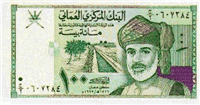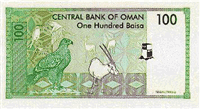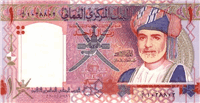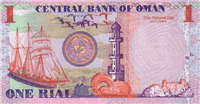Exchange Currency
Omani rial
The rial is the currency of Oman. It is divided into 1000 baisa (also written baiza, Arabic: بيسة).
Hellenistic coins were used in Oman as early as the third century BC. Sasanian coins were also used in Oman, but the first locally minted coins were produced by the local Umayyad governor in 708 AD. Nevertheless, most coins used in Oman were imported Islamic coins from Iran and Iraq. The Portuguese imported coins when they occupied Oman, and Iranian copper coins were imported when the Safavids controlled Oman.
In 1893, Sultan Faisal ibn Turki issued copper coins in Indian denominations. In 1940, Sultan Sa'id Ibn Timur introduced a new coin system based upon the riyal, the Arabic name for the Maria Theresa Thalers, with one riyal equal to 200 baisa. Separate coins were issued for Oman and for Dhofar.
Maria Theresa Thalers (XMT T) circulated in the interior of Muscat and Oman, and the Indian Rupee (INR) circulated in the coastal regions of Muscat and Oman and was the official currency until the 1959. The Baiza was the lowest denomination coin, with 1 Maria Theresa Thaler equal to 230 Baiza and 1 Indian Rupee equal to 64 Baiza. In the early 1900s, trade accounts were kept in an imaginary currency. Its units were 1 "white mohammedi" = 20 gaz; 11.5 white mohammedia = 1 Maria Theresa thaler = 20.5 "black mohammedia." The white mohammedi was used as a unit of account in retail trade, the black mohammedi in wholesale trade. The Persian Gulf Rupee (XPG) replaced the Indian Rupee at par on April 1, 1959. India devalued its Rupee on June 6, 1966 which affected the value of the Gulf Rupee, forcing the states using the Gulf Rupee to introduce their own currency.
When the Sultanate of Oman was established in 1970, Oman replaced the Persian Gulf Rupee with the Oman Rial Saidi (OMS) on May 7, 1970, which was introduced at par with the British Pound Sterling and equal to about 21 Persian Gulf Rupees. The Rial Omani (OMR) replaced the Rial Saidi on November 11, 1972 at par. Banknotes were issued by the Sultanate of Muscat and Oman from 1970 until 1973, by the Oman Currency Board from 1973 until 1977, and by the Central Bank of Oman from 1977 on. The Rial Saidi and Rial Omani are divisible into 1000 Baiza.
In 1940, coins were issued for use in Dhofar in denominations of 10, 20 and 50 baisa. ½ rial coins were added in 1948, followed by 3 baisa in 1959. In 1946, 2, 5 and 20 baisa coins were introduced for use in Oman. These were followed, between 1959 and 1960, by 3 baisa, ½ and 1 rial coins.
In 1970, a coinage for all of Muscat and Oman was introduced. Denominations were 2, 5, 10, 25, 50 and 100 baisa. In 1975, new coins were issued with the country's name given as Oman. ¼ and ½ rial coins were introduced in 1980.
100 baisa, ¼ rial Omani, and ½ rial Omani coins made of non-precious metal were also issued in the 1980s.
A new 1 rial note is now in circulation alongside the 1970 note which is still accepted. The new 1 rial note is red, similar to the 5 rials note. A new purple 20 rials note was issued in 2010 on the occasion of the 40th National Day.Both the old and the new notes are accepted. The 200 baisa note is now out of circulation.
Although the 100 baisa and 20 rials notes are both green, the former is considerably smaller, and thus the two are easily distinguishable.
Summary info
Summary information about Omani rial- ISO 4217 Code:
- OMR
- Currency sign:
- ر.ع.
- Country:
- Oman
- Subunit:
- baisa
- Coins:
- 5 baisa, 10 baisa, 25 baisa, 50 baisa
- Banknotes:
- 100 baisa, 200 baisa, 0.5 rial, 1 rial, 5 rials, 10 rials, 20 rials, 50 rials
- Central bank:
- Central Bank of Oman
History
Muscat, the capital, was occupied by the Portuguese from 1508 to 1648, by the Ottoman Turks from 1648 until 1741 when Ahmad ibn Said forced them out. Muscat and Oman became a de facto sovereign state in 1784, expanded to the east, and for a while, Zanzibar was the capital of the Oman Sultanate. Zanzibar separated from Muscat and Oman on April 6, 1861. Muscat and Oman became an informal British protectorate in 1891, and the Sultanate of Oman was established on August 9, 1970.Hellenistic coins were used in Oman as early as the third century BC. Sasanian coins were also used in Oman, but the first locally minted coins were produced by the local Umayyad governor in 708 AD. Nevertheless, most coins used in Oman were imported Islamic coins from Iran and Iraq. The Portuguese imported coins when they occupied Oman, and Iranian copper coins were imported when the Safavids controlled Oman.
In 1893, Sultan Faisal ibn Turki issued copper coins in Indian denominations. In 1940, Sultan Sa'id Ibn Timur introduced a new coin system based upon the riyal, the Arabic name for the Maria Theresa Thalers, with one riyal equal to 200 baisa. Separate coins were issued for Oman and for Dhofar.
Maria Theresa Thalers (XMT T) circulated in the interior of Muscat and Oman, and the Indian Rupee (INR) circulated in the coastal regions of Muscat and Oman and was the official currency until the 1959. The Baiza was the lowest denomination coin, with 1 Maria Theresa Thaler equal to 230 Baiza and 1 Indian Rupee equal to 64 Baiza. In the early 1900s, trade accounts were kept in an imaginary currency. Its units were 1 "white mohammedi" = 20 gaz; 11.5 white mohammedia = 1 Maria Theresa thaler = 20.5 "black mohammedia." The white mohammedi was used as a unit of account in retail trade, the black mohammedi in wholesale trade. The Persian Gulf Rupee (XPG) replaced the Indian Rupee at par on April 1, 1959. India devalued its Rupee on June 6, 1966 which affected the value of the Gulf Rupee, forcing the states using the Gulf Rupee to introduce their own currency.
When the Sultanate of Oman was established in 1970, Oman replaced the Persian Gulf Rupee with the Oman Rial Saidi (OMS) on May 7, 1970, which was introduced at par with the British Pound Sterling and equal to about 21 Persian Gulf Rupees. The Rial Omani (OMR) replaced the Rial Saidi on November 11, 1972 at par. Banknotes were issued by the Sultanate of Muscat and Oman from 1970 until 1973, by the Oman Currency Board from 1973 until 1977, and by the Central Bank of Oman from 1977 on. The Rial Saidi and Rial Omani are divisible into 1000 Baiza.
Coins
In the 1890s, coins for 1⁄12 and ¼ anna (⅓ and 1 paisa) were minted specifically for use in Muscat and Oman.In 1940, coins were issued for use in Dhofar in denominations of 10, 20 and 50 baisa. ½ rial coins were added in 1948, followed by 3 baisa in 1959. In 1946, 2, 5 and 20 baisa coins were introduced for use in Oman. These were followed, between 1959 and 1960, by 3 baisa, ½ and 1 rial coins.
In 1970, a coinage for all of Muscat and Oman was introduced. Denominations were 2, 5, 10, 25, 50 and 100 baisa. In 1975, new coins were issued with the country's name given as Oman. ¼ and ½ rial coins were introduced in 1980.
100 baisa, ¼ rial Omani, and ½ rial Omani coins made of non-precious metal were also issued in the 1980s.
Banknotes
On 7 May 1970, the Sultanate of Muscat and Oman issued banknotes in denominations of 100 baiza, ¼, ½, 1, 5 and 10 rials saidi. These were followed by notes for 100 baiza, ¼, ½, 1, 5 and 10 Omani rials issued by the Oman Currency Board on 18 November 1972. From 1977, the Central Bank of Oman has issued notes, with 20 and 50 rials notes introduced that, followed by 200 baisa notes in 1985.A new 1 rial note is now in circulation alongside the 1970 note which is still accepted. The new 1 rial note is red, similar to the 5 rials note. A new purple 20 rials note was issued in 2010 on the occasion of the 40th National Day.Both the old and the new notes are accepted. The 200 baisa note is now out of circulation.
Although the 100 baisa and 20 rials notes are both green, the former is considerably smaller, and thus the two are easily distinguishable.
OMR banknotes pictures gallery
| 100 Omani rials | |
|---|---|
| Banknote of 100 Omani rials has dimensions 121×64 mm and main colors are hunter green, cambridge blue, moss green, tea green, cambridge blue, dark gray, white, beige and fern green. The banknote of 100 Omani baisa was issued in 1995. | |
 Obverse side of the 100 Omani rials is showing the portrait of Sultan Qaboos bin Said al Said and an irrigation canal. |
 Reverse side of the 100 Omani rials is showing an Eagle, an oryx and other animals and birds. |
| 200 Omani rials | |
|---|---|
| Banknote of 200 Omani rials has dimensions 128×64 mm and main colors are aurometalsaurus, cool grey, pastel blue, wild blue yonder, manatee, mint cream and white smoke. The banknote of 200 Omani baisa was issued in 1995. | |
 Obverse side of the 200 Omani rials is showing the portrait of Sultan Qaboos bin Said al Said and an airport. |
 Reverse side of the 200 Omani rials is showing the Marine Science and Fisheries Centre. |
| 0.5 Omani rials | |
|---|---|
| Banknote of 0.5 Omani rials has dimensions 135×64 mm and main colors are khaki, pale silver, bazaar, grullo, dark gray, pale chestnut, thistle and snow. The banknote of 0.5 Omani rial was issued in 1995. | |
 Obverse side of the 0.5 Omani rials is showing the portrait of Sultan Qaboos bin Said al Said and Bahla Castle. |
 Reverse side of the 0.5 Omani rials is showing the Nakhl Fort and Al-Hazm Fort. |
| 1 Omani rial | |
|---|---|
| Banknote of 1 Omani rial has dimensions 145×76 mm and main colors are puce, tea rose, old rose, pink pearl, classic rose, desert sand, dark lavender and linen. The banknote of 1 Omani rial was issued in 2005. | |
 Obverse side of the 1 Omani rial is showing the portrait of Sultan Qaboos bin Said Al Said, Sultan Qaboos Sports Complex. |
 Reverse side of the 1 Omani rial is showing the Omani Khanjar (dagger), silver bracelets and ornaments and dhows. |
| 5 Omani rials | |
|---|---|
| Banknote of 5 Omani rials has dimensions 153×76 mm and main colors are khaki, antique brass, cinereous, light taupe, chamoisee, beaver, seashell, pale silver and pale copper. The banknote of 5 Omani rials was issued in 2010. | |
 Obverse side of the 5 Omani rials is showing the portrait of Sultan Qaboos bin Said Al Said and Sultan Qaboos University. |
 Reverse side of the 5 Omani rials is showing an image of Nizwa city: Nizwa Fort and Grand Mosque. |
| 10 Omani rials | |
|---|---|
| Banknote of 10 Omani rials has dimensions 160×76 mm and main colors are seal brown, taupe, cambridge blue, wild blue yonder, sand, dark tan, copper rose, french beige, shadow and floral white. The banknote of 10 Omani rials was issued in 2010. | |
 Obverse side of the 10 Omani rials is showing the portrait of Sultan Qaboos bin Said Al Said, Salalah Clock Tower, Palm and Boswellia tree. |
 Reverse side of the 10 Omani rials is showing the Mutrah Fort in Muscat province and Corniche - waterfront promenade. |
| 20 Omani rials | |
|---|---|
| Banknote of 20 Omani rials has dimensions 166×76 mm and main colors are ceil, pale silver, wild blue yonder, carolina blue, desert sand, ivory and gray. The banknote of 20 Omani rials was issued in 2010. | |
 Obverse side of the 20 Omani rials is showing the portrait of Sultan Qaboos bin Said Al Said and Central Bank of Oman building (Muscat). |
 Reverse side of the 20 Omani rials is showing Muscat Security Market and Rusayl industrial area. |
| 50 Omani rials | |
|---|---|
| Banknote of 50 Omani rials has dimensions 174×76 mm and main colors are beaver, puce, lavender gray, pastel purple, light thulian pink, opera mauve, rosy brown and pale pink. The banknote of 50 Omani rials was issued in 2010. | |
 Obverse side of the 50 Omani rials is showing the portrait of Sultan Qaboos bin Said Al Said, Ministry of Finance and Economy Building (Muscat). |
 Reverse side of the 50 Omani rials is showing Cabinet building and Ministry of Finance and Industry building (Muscat). |
Useful links
- About Central Bank of Oman:
- Central Bank of Oman
- List of currencies:
- Currencies
- Security and design features of OMR banknotes:
- OMR banknotes
- OMR currency on Wikipedia:
- Omani rial
- Official Website of Central Bank of Oman:
- Commemorative coins:
- Commemorative Coins